Dog and Cat Pet Enthusiast_Senior Pooper Scooper Shares Practical Pet Care Tips
Taking care of pets is an act full of love and responsibility, especially for dogs and cats, our most common "fur kids." From the moment they enter our homes, they become part of our family, and their health, happiness, and wellbeing are closely tied to us. As a senior pooper scooper, I want to share some practical pet care tips to help new pet owners better care for their fur kids, avoid detours, and make pet life easier and more enjoyable.
The "soul-searching question" before getting a pet: Are you really ready?

Before bringing a cute dog or cat home, please ask yourself a "soul-searching question": Are you truly ready to take on the responsibility of a life? Pet care is not just about providing food and shelter; it requires a significant investment of time, energy, money, and love.
First, consider your financial ability. The expenses of keeping a pet go beyond just dog or cat food. In addition to daily meals, there are vaccinations, deworming, physical exams, medical care, grooming, toys, and more. According to reports, the average lifetime cost of owning a cat in China is about 140,000 RMB. Although the specific amount varies depending on pet breed, lifestyle, and medical needs, spending several thousand RMB per year is unavoidable. In case of sudden illness or accidents, medical costs can reach thousands or even tens of thousands of RMB, like a "gold-swallowing beast," requiring sufficient financial foundation to cope.
Second, time management is also important. Dogs need walks, training, and companionship. Though cats are relatively independent, they also need your interaction and grooming. If you are often busy with work, frequently traveling, or working overtime, you may not have enough time to be with them, which can make them feel lonely or cause behavioral problems.
Finally, family opinions are critical. Owning a pet involves the whole family and requires agreement and support from all members, especially if there are elderly, children, or allergic members in the household. Communication beforehand is essential.
If you have carefully considered and confirmed you are ready, congratulations—you are about to embark on a pet-raising journey full of love and surprises!
Welcoming the new member: Do thorough preparations
Before the new member arrives, some preparations are necessary to help them adapt to the new environment faster.
- Create a safe and comfortable "small nest": Designate a pet-exclusive area at home beforehand, prepare a cozy pet bed, food bowl, water bowl, and litter box (if it’s a cat). It’s best to choose food and water bowls that are not easy to tip over. The choice of litter box is also important; there are open, semi-closed, fully closed, and automatic types on the market, which should be selected according to the cat’s habits.
- Stock up on daily supplies: Dog food/cat food, pet-specific shampoo, comb, nail clippers, leash (for dogs), and other daily supplies should all be prepared in advance. When selecting pet food, consider the pet’s age, size, breed, and activity level, prioritizing high-meat-content and low-additive quality cat or dog food.
- Cleaning and disinfecting: Prior to the pet’s arrival, it’s best to give your home a thorough cleaning and disinfection, especially corners and places under beds where cats and dogs like to hide.
- Learn basic information about the pet: If you obtain the pet through purchase or adoption, learn in advance about their previous diet, deworming, and vaccination status. It’s best to ask the seller for some of the food the pet previously ate to gradually transition food at home, avoiding digestive discomfort.
New member arrives: Patience and understanding are key
When first arriving in a new environment, dogs and cats may feel nervous and uneasy, and stress reactions are normal. At this time, patience and understanding from the owner are most important.
- Give them space to adjust: Do not get too close immediately; let them adapt in a relatively quiet and small space, like one room. Once they gradually relax, slowly allow them to explore other areas of the home.
- Don’t rush to bathe: Avoid bathing pets within the first week of arrival to prevent colds or stress reactions, especially puppies and kittens. Only bathe them after they are fully adapted to the new environment and at least one week after all vaccinations are complete. Always use pet-specific shampoo and maintain appropriate water temperature during baths.
- Gradual food transition: When changing pet food, use the "seven-day" or "ten-day" gradual replacement method, mixing old and new food and slowly increasing the new food proportion to allow the pet’s digestive system to adapt.
Daily care: Details determine health
Daily care is key to ensuring pet health.
- Diet: Follow the principle of fixed times and quantities for feeding to avoid overfeeding and obesity. Ensure ample clean drinking water is provided.
- Cleaning: Regularly groom pets, especially during shedding season, which can effectively reduce hair loss and strengthen bonds. Clean pets’ ears and eyes regularly. Based on skin characteristics, frequent bathing is not recommended—dogs generally need bathing once every one to two weeks. Cats can be bathed as needed.
- Oral care: Brush pets’ teeth regularly to prevent oral diseases.
- Deworming: Conduct internal and external deworming regularly, an important measure to prevent parasitic diseases. Puppies and kittens can start the first deworming around 45 days old, then monthly deworming; adult pets can be dewormed quarterly.
- Vaccination: Vaccinate pets on schedule as advised by veterinarians to prevent infectious diseases. Puppies and kittens usually start vaccinations between 6-8 weeks of age, requiring multiple injections and annual boosters thereafter.
- Health check-ups: Even if pets seem healthy, regular veterinary check-ups are recommended. Young pets with weaker immunity should be checked before going home or within 30 days of birth. Healthy adult pets should be checked once a year. Senior pets over 7 years old should have check-ups twice a year due to higher chronic disease risks. Regular check-ups help detect and treat potential health issues early.
Training and behavior: Patience in guidance, positive reinforcement
Both dogs and cats require appropriate training and behavior guidance to better integrate into family life.
- Correct bad behavior promptly: When pets show unwanted behaviors, correct them immediately. For example, if a dog urinates in the wrong place, stop it immediately and guide it to the correct spot using brief, firm commands.
- Positive reinforcement: Use rewards (treats, praise, petting, or toys) to reinforce good behaviors and help pets associate good behavior with positive outcomes.
- Maintain consistency: Family members must keep instructions and attitudes consistent during training to avoid confusing the pet.
- Understand pet needs: Often, bad behavior results from unmet needs such as excess energy, boredom, or lack of security. Increasing exercise, providing engaging toys, and spending more time with them can effectively reduce unwanted behavior.
- Seek professional help: For challenging behavioral issues, consider consulting professional pet behavior trainers.
Neutering: An important decision
Neutering pets is a matter worth serious consideration. In the long term, it offers many health benefits.
- Reduce disease risks: Neutering effectively prevents many reproductive system diseases, such as pyometra and mammary tumors in female dogs, testicular tumors, and prostate diseases in males. Particularly for female dogs, neutering before the first heat greatly reduces the incidence of mammary tumors.
- Improve behavioral problems: Neutering reduces heat-related behavioral issues like howling in female cats, marking by male cats, and aggression in dogs.
- Control pet population: Neutering is an effective method to control stray animal numbers and reduce unwanted breeding.
Of course, neutering carries risks mainly related to surgery and anesthesia, as well as possible postoperative obesity. After neutering, a pet’s metabolism may decrease, making them more prone to weight gain, so managing weight through diet control and increased exercise is necessary. For the best timing of neutering, consult your veterinarian based on your pet’s specific situation.
Frequently Asked Questions
- How often should pets have check-ups? Young pets should have check-ups before going home or within 30 days of birth; adult pets once a year; senior pets every six months.
- What are the benefits of neutering pets? It prevents various reproductive diseases, improves behavioral problems, and controls pet population.
- How to transition pet food? Use a gradual method like the seven-day or ten-day transition to avoid sudden changes causing digestive issues.
- How to train pets? Follow principles of positive reinforcement, immediate correction, and consistency; understand pet needs, and seek professional help if necessary.
- How much does it cost to keep a pet for a year? Costs vary by pet, but several thousand RMB annually is common. Medical expenses can be significant additional costs.
Keeping dogs and cats is a sweet responsibility. Although challenges arise, the happiness and companionship our fur kids bring are unmatched. I hope this article helps you become a qualified pooper scooper and enjoy a wonderful life with your fur kids!
-560x560.webp)


